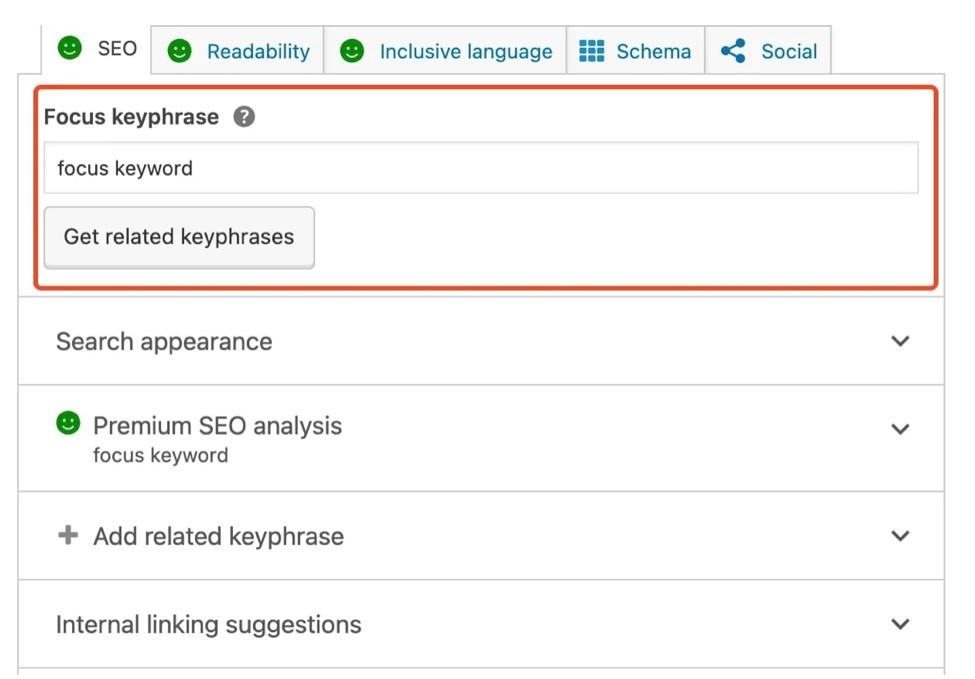In a nutshell: What is a focus keyphrase?
"Focus keyphrase" is an alternative term for "focus keyword" and "main keyword". The term "focus keyphrase" gained notoriety primarily through its use in the popular WordPress plugin Yoast SEO. In search engine optimization, it is essential to analyse a focus keyphrase for each page created. You then create high-quality content to match this keyphrase in order to achieve the highest possible rankings in search engine results (Google, Yahoo, etc.).
Focus keyphrase: definition and relevance for SEO
A focus keyphrase is a word or a term consisting of several words for which the website in question should rank as high as possible in the search engines. Take the focus keyphrase "old building renovation tips" as an example. This example shows that a focus keyphrase can also consist of several words.
Websites are usually optimized for a focus keyphrase, which includes the text creation for this page and the technical optimization of the page. Through targeted search engine optimization (SEO) on a focus keyphrase, webmasters are able to provide suitable and high-quality content - especially with a focus on this keyphrase. Accurate content attracts website visitors, who ideally stay on the page or the entire website for as long as possible due to the quality of the content. A long dwell time increases the likelihood that the webmaster will achieve the goal they are aiming for on the web (e.g. increase sales figures, generate leads, increase traffic ).
-
Free
SEO strategy meeting
In a free SEO strategy consultation, we uncover untapped potential and develop a strategy to make you more successful on Google.

- More organic visibility
- More organic visitors to your website
- More inquiries & sales
Keyword analysis: Tips for choosing the focus keyphrase
Choosing a strategically good focus keyphrase is essential for SEO. It is important to choose a keyphrase that matches the existing content of the entire website and adds a meaningful subpage to the website. In addition, the chosen focus keyphrase should not be too competitive.
Thanks to the choice of a good focus keyphrase, the webmaster will have a chance of achieving a high ranking in the search engines within a few weeks or months with the page created for this focus keyphrase. To achieve this, it is essential to use SEO tools and analyze the search volume and the keyword difficulty of various keyphrases and take a look at competitor sites. If the competitor sites are well-known websites with a high authority, then it is better to choose an alternative focus keyphrase for which it is easier to achieve a high ranking.
- Do you know my SEO newsletter?
Register now and receive regular tips from the experts.
After the keyword analysis: content is king
After selecting the focus keyphrase, the following tips should be considered:
- High-quality content (e.g. text, images, infographics, videos) is created on the topic. High quality means, among other things, that the page offers more depth of content compared to the top-ranked competitor pages.
- The consideration of the search intention is extremely relevant. When users start search queries, they do so for one reason: they expect the pages that appear in the search results to provide them with certain knowledge. The knowledge that users want differs for each focus keyphrase. Webmasters must determine the search intentions of keyphrases and create content that meets the needs of as many users as possible.
- Technical optimization of the page for the focus keyphrase is also essential. In the title tag and in the meta description, the URL, the main heading and the subheadings, in the body text and, if applicable, in image descriptions, the keyphrase should appear.
- In addition to the focus keyphrase, there are secondary keywords that are relevant in connection with the keyphrase. The appropriate and most frequently searched secondary keywords that belong to the focus keyphrase should be analyzed using SEO tools and used in the text.
These are the most important tips for using the focus keyphrase in online marketing. For the SEO of any website, it is immensely important to define focus keyphrases for each subpage and to create and optimize content based on these focus keyphrases.
Difference between main keyword and focus keyphrase
What was described in this glossary entry as a focus keyphrase is generally known as a "main keyword". In fact, the focus keyphrase is nothing more than a synonym for the term "main keyword". This synonym has become well-known because it is used in the popular WordPress plugin Yoast SEO. The focus keyword in the Yoast plugin used to be called "focus keyword", but this term no longer exists and has been replaced by "focus keyphrase".

The screenshot shows an excerpt from the Yoast SEO plugin. Many WordPress users use it to SEO their website. The screenshot shows the input field in which the focus keyphrase is entered. When using Yoast SEO, webmasters should note that the plugin only evaluates some aspects of keyword optimization - for example, the inclusion of the focus keyphrase in the title tag, headings and text in general. Although these are essential criteria for the keyword optimization of a website, it should never be forgotten that Yoast SEO ignores some important criteria. This includes, for example, checking the search intent associated with the focus keyphrase.
Webmasters should therefore by no means see the SEO plugin as a fully comprehensive tool for checking and evaluating the keyword optimization of a page, but should only use it as a supporting tool in SEO. For each focus keyphrase, it is important to take into account the information on choosing the focus keyphrase and content creation mentioned in the previous section. Yoast SEO does not do this for you.
Examples of focus keyphrases
Below we list some examples of focus keyphrases, including both short-tail and long-tail keywords. long-tail keywords are mentioned. A short-tail keyword is characterized by the fact that it consists of one to two words. There are also long-tail keywords, which are made up of more words. It can also be differentiated into mid-tail keywords. However, as the line between short-tail, mid-tail and long-tail keywords is often difficult to draw, we will leave it at two keyword categorizations in the following.
In general, short-tail keywords are not very specific and therefore highly competitive. As a result, websites with a high authority and a lot of traffic are usually optimized for these keywords. Less popular websites that have yet to grow prefer to use the specific long-tail keywords, which usually have a lower search volume and less competition.
|
Shorttail keywords |
Longtail keywords |
|
|
The examples listed not only show the difference between short-tail and long-tail keywords, but also how the more specific long-tail keywords are derived from short-tail keywords. Websites with a low authority can use several longtail keywords instead of one comprehensive page for a shorttail keyword and create subpages for them. In this way, they will most likely achieve more traffic and gain enough authority to achieve a high ranking in the search results for the short-tail keyword in the future.
Conclusion: What is a focus keyphrase?
A focus keyphrase should be selected for each new website. Secondary keywords are analyzed, content is created and technical SEO measures are taken to match this keyphrase. By optimizing the page specifically for a focus keyphrase, webmasters lay the foundation for a good ranking of the created page and for the growth of the entire website.






